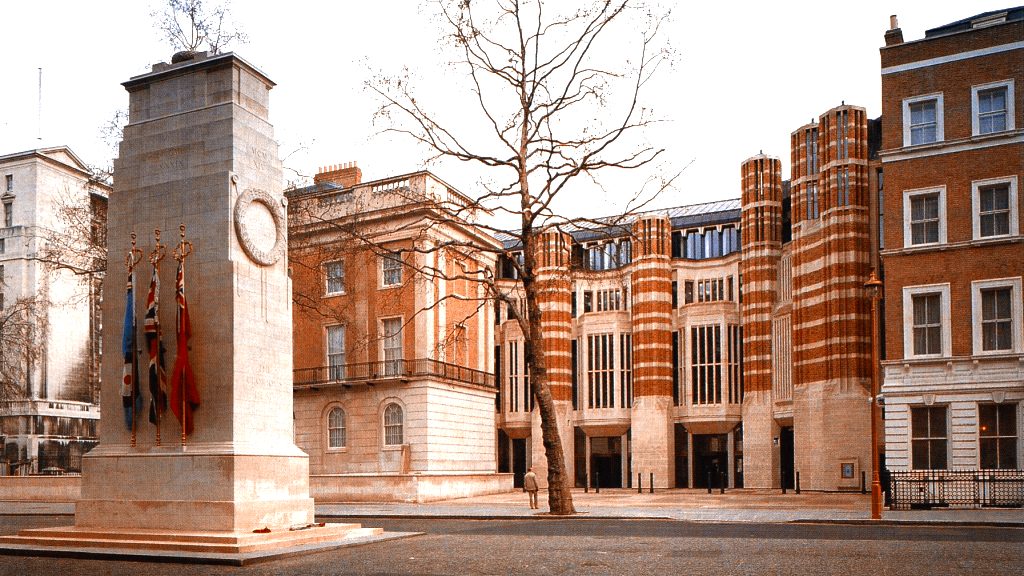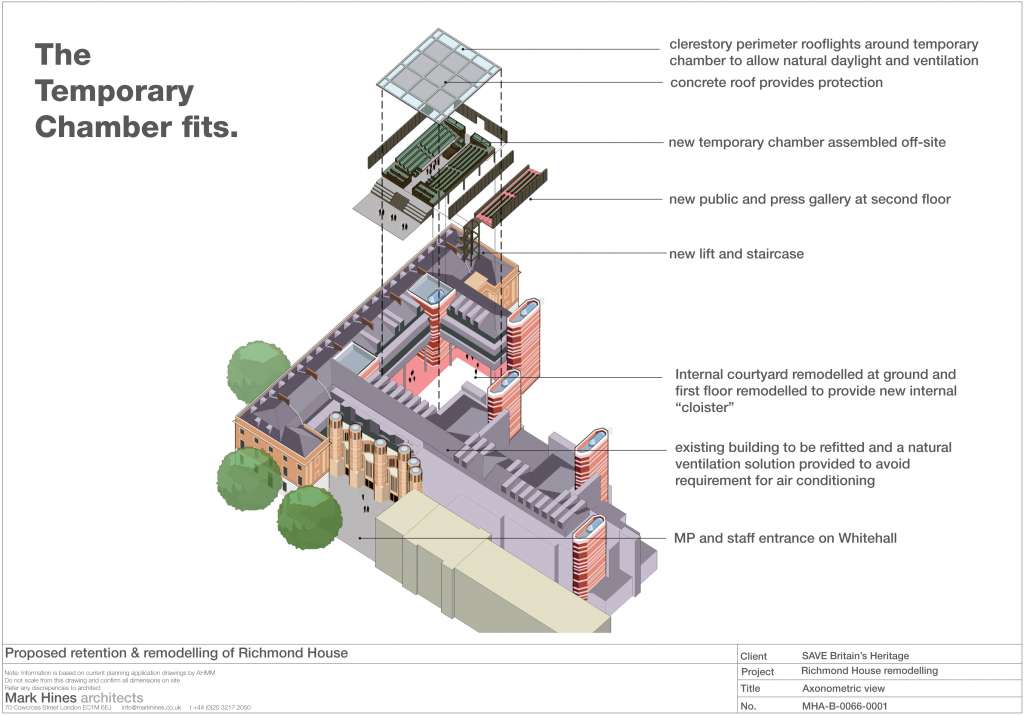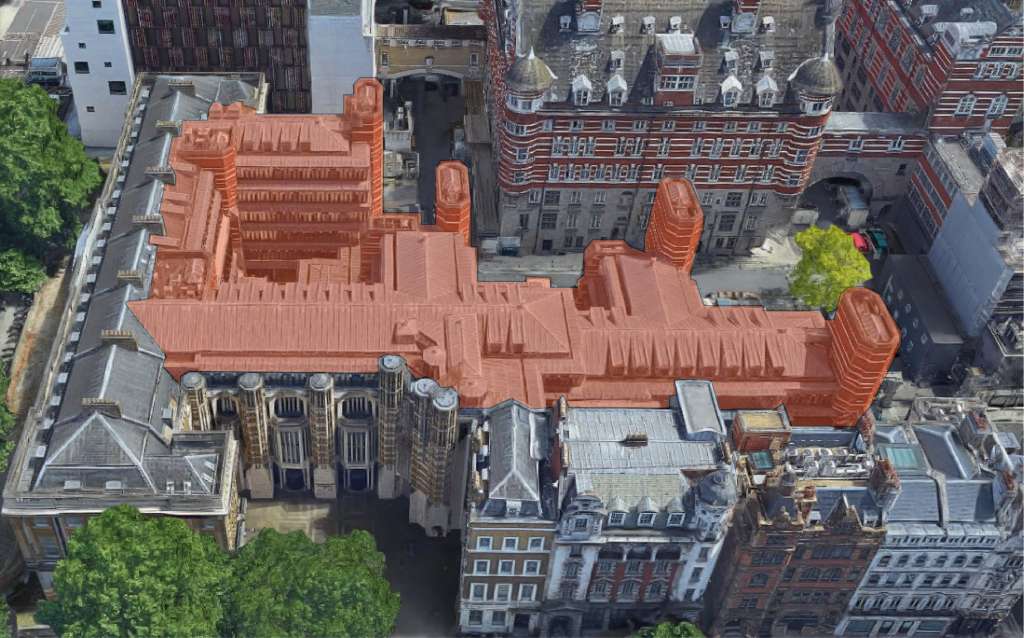Richmond House: Parliamentary report recognises major cost savings in SAVE approach
12th March 2021
SAVE Britain’s Heritage is pleased to find that our alternative scheme for retaining Richmond House, drawn up with Mark Hines Architects, is cited as the “the cheapest of the shortlisted schemes by some way”, in a report published yesterday by the Sponsor body charged with reviewing the costs of restoring the Palace of Westminster.
The big question posed is whether MP’s and peers will at last see that Parliament’s original plans for an expensive rebuilding of 34 year old Richmond House is unnecessarily extravagant, wasteful and destructive, and not the only available option to deliver the project. Though the reasoning and conclusions of the report are often hard to follow given the redaction of all monetary figures and costs, it does now recognise that a ‘do the minimum’ approach, such as that proposed by SAVE, not only exists, but would be the cheapest and fastest solution in contrast to the ‘do the maximum’ demolition approach originally proposed.
Marcus Binney, executive president of SAVE Britain’s Heritage says: “We call on Parliament to publish the costs of the alternatives which have been shamefully blanked out of numerous pages of the report.”
Henrietta Billings, director of SAVE Britain’s Heritage says: “The 'do minimum' no demolition approach to Richmond House remains the cheapest, quickest, most sustainable and least destructive option for a temporary MPs chamber. We will continue pressing our case with MPs, Lords and the Government as the plans develop.”
Commissioned in May 2020 by the Sponsor Body in charge of the Restoration and Renewal programme, the report is the result of a wide-ranging review of options to temporarily relocate all MPs and Peers while essential restoration work takes place at the Palace of Westminster.
The review was originally announced following controversy surrounding spiralling projects costs and the economic impact of the COVID 19 pandemic. The review was tasked with considering the balance of cost, timescales and requirements associated with the project in order to ensure best use of public money in line with recommendations made in a critical report by the National Audit Office.
SAVE has also strongly challenged the hugely expensive proposal to internally rebuild the Queen Elizabeth II Conference Centre for a temporary House of Lords Chamber, including a luxury roof-top terrace and restaurant for Peers. The details of the brief and cost for these proposals has been redacted, but we nonetheless welcome the new ‘do the minimum’ approach recommended in the report. This includes using the existing 600-seat auditorium rather than creating a new lofty chamber of Pugin proportions which would require blasting through concrete floor space and major structural reinforcement.
SAVE points out that the main reason for firmly rejecting Parliament’s original proposals for the rebuilding of Richmond House is that it delays the vital renewal of dangerous wiring and services in the Palace or Westminster to the latest possible date of 2027. It would also involve knocking down a grade II* listed, massively built, thermally efficient 34-year-old building and then reconstructing it on a similar footprint. This has the worst carbon footprint of all the proposals.
The report also outlines that one of ten essential objectives of the entire Restoration & Renewal programme is sustainability and the need to “Use proven technology and solutions that meet…Parliament’s goal of becoming carbon-neutral by 2050.” It goes on to state the need to “Deliver industry leading exemplar solutions, which…exceed the legislative, statutory and planning obligations for sustainability.”
Despite these objectives, the report fails to address key concerns regarding the high carbon cost of Parliament’s original demolition plans (previously shown to carry the highest carbon cost of all options) versus the sustainability benefits of retrofitting the existing Richmond House, an approach fully assessed in an academic study commissioned by SAVE from the University of Westminster and published in May 2020.
In our view, the scoring system used in the report to justify adherence to the demolition and rebuild option for Richmond House is not convincing and is no substitute for the actual build cost figures which are systematically withheld. The public have a right to know where their money is being spent. The demolition and rebuild approach was conceived before COVID, at a time when public money was thought to be available for lavish new buildings and extended facilities. If Parliament proceeds with its original inflated scheme, it will be spending more money of temporary accommodation than Henry VIII spent on the Field of the Cloth of Gold, 500 years ago.
We argue that in an age of climate crisis, the retrofitting of Richmond House is an extraordinary opportunity for the UK government to demonstrate its commitment to the country and the climate in a very public manner and lead the way in showing what can be done by transforming one of its very own buildings into a landmark low energy building of national importance.
The report deals unfairly with a scheme proposed by Foster + Partners to build two temporary chambers for both Houses at Horse Guards Parade, saying it provides no long term benefits for Parliament, when the whole point of the design is that it can be dismantled and re-erected for use elsewhere.
The report also manifests a rear guard action by the proponents of demolishing and rebuilding Richmond House who are trying to argue that a third, wholly unnecessary ‘legacy’ Commons chamber is in the public interest, and that the £1billion plus price tag for delivering this by demolishing 99% of a grade II* listed building has merits over alternatives costed by Ian Ritche, quantity surveyors and Foster + Partners at just £20m, £55m and £125m.
WHAT YOU CAN DO
Write to YOUR MP demanding that Parliament’s original plan to demolish and rebuild Richmond House is ditched in favour of the more minimal approaches set out in the report which deliver on heritage, the environment and value for money.
ENDS
Notes to editors
1. For more information and images contact Ben Oakley, Conservation Officer at SAVE Britain's Heritage: oakley@savebritainsheritage.org/ 07388 181 181.
2. Images from top: Richmond House, standing opposite the Cenotaph at 79 Whitehall (Country Life) / SAVE's alternative scheme for placing a temporary Commons chamber in the courtyard of a retained Richmond House (Mark Hines) / Image showing in red the extent of Richmond set to be demolished under Parliament's current plans (SBH) / The impressive rear façade of Richmond House, also set to be lost under existing plans (Country Life).
3. SAVE Britain’s Heritage has been campaigning for historic buildings since its formation in 1975 by a group of architectural historians, writers, journalists and planners. It is a strong, independent voice in conservation, free to respond rapidly to emergencies and to speak out loud for the historic built environment.




